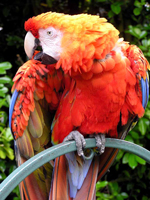This is a list of software palettes used by computers. Systems that use a 4-bit or 8-bit pixel depth can display up to 16 or 256 colors simultaneously. Many personal computers in the early 1990s displayed at most 256 different colors, freely selected by software (either by the user or by a program) from their wider hardware's RGB color palette.
Usual selections of colors in limited subsets (generally 16 or 256) of the full palette includes some RGB level arrangements commonly used with the 8-bit palettes as master palettes or universal palettes (i.e., palettes for multipurpose uses).
These are some representative software palettes, but any selection can be made in such of systems.
For specific hardware color palettes, see the List of monochrome and RGB palettes, List of 8-bit computer hardware graphics, the List of 16-bit computer hardware graphics and the List of video game console palettes articles.
Each palette is represented by an array of color patches. A one-pixel size version appears below each palette, to make it easy to compare palette sizes.
For each unique palette, an image color test chart and sample image (truecolor original follows) rendered with that palette (without dithering) are given. The test chart shows the full 8-bit, 256 levels of the red, green, and blue (RGB) primary colors and cyan, magenta, and yellow complementary colors, along with a full 8-bit, 256 levels grayscale. Gradients of RGB intermediate colors (orange, lime green, sea green, sky blue, violet and fuchsia), and a full hue spectrum are also present. Color charts are not gamma corrected.
These elements illustrate the color depth and distribution of the colors of any given palette, and the sample image indicates how the color selection of such palettes could represent real-life images.

